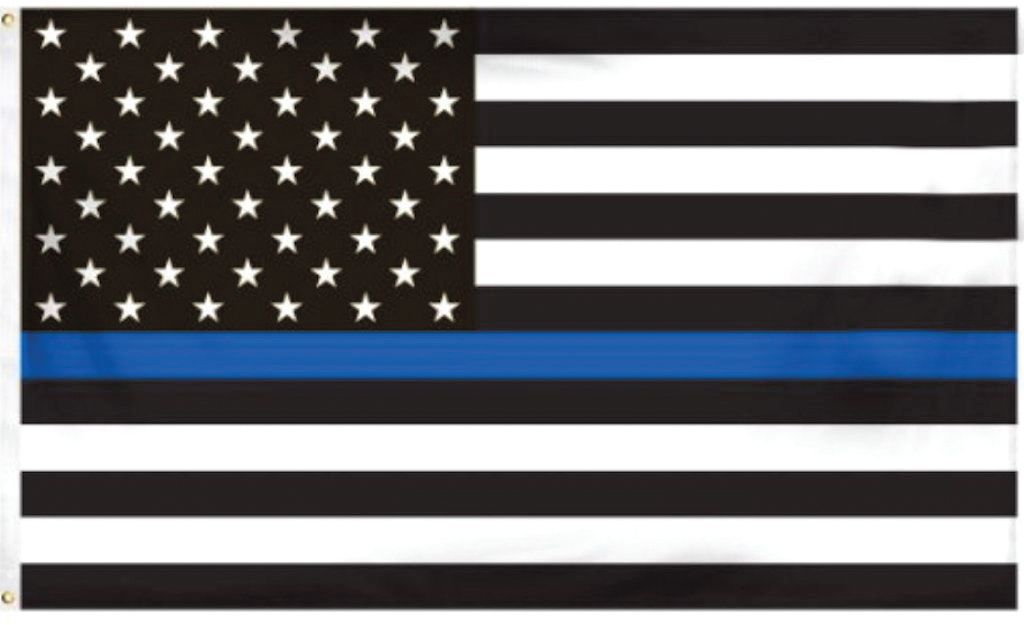
‘Thin Blue Line’ flag has a local strident history Honoring law enforcement or yielding to extremism?
By Merdies Hayes
Managing Editor
The phrase “Thin Blue Line” has drawn controversy over the past year. It refers to an augmented version of the American flag with black and white stripes and a distinct blue line running horizontally across the middle.
Those who fly the flag say they stand in solidarity with law enforcement as it serves as a solemn tribute to fallen officers. The flag has also been displayed by White supremacists, particularly appearing prominently next to Confederate flags at the 2017 “Unite the Right” rally in Charlottesville, Va.
The idea is quite old, tracing back to an 1854 British battle formation (“thin red line”) used during the Crimean war and later popularized in art, poetry and song. The flag was occasionally used by police and caught on in 1922 in New York City after the police commissioner faced criticism of his leadership. The phrase began showing up in political stump speeches and related press coverage from Chicago to Los Angeles.
In the 1950s, “The Thin Blue Line” was the title of a short-lived TV show about the Los Angeles Police Department. It was the brainchild of LAPD Chief William H. Parker, who took advantage of Hollywood’s proximity to make public relations a key part of his tenure. Parker at the time opened up the department’s files to the writers of “Dragnet.”
Parker was an unambiguous racist. He once said some immigrants were “not far removed from the wild tribes of Mexico,” and compared Black residents ensnared in the 1965 Watts Riots to “monkeys in a zoo.” Parker used the phrase “thin blue line” constantly in his speeches.
The phrase was further popularized by author Joseph Wambaugh (himself a former LAPD officer) in typifying Parker’s philosophy representing a hard-nosed, ex-military and stalwart police reformer out to end corruption and professionalize the city’s police force.
Parker largely believed that law enforcement was there to protect Western civilization from communists, minorities, progressive politicians and generally any dissident or agitator that didn’t fit into his viewpoint. It was during Parker’s tenure that a bigger shift toward militarism in law enforcement commenced when he began to procure equipment directly from the Department of Defense.
The phrase was further popularized with Errol Morris’ 1988 film “The Thin Blue Line” in which a Dallas judge quotes a prosecutor describing what separates “the public from anarchy.” Over the years, officers nationwide have occasionally placed stickers of a blue line surrounded by a black background on their personal cars.
After the ambush of Dallas officers in 2016, the flag became a common sight in yards and on bumper stickers around the city along with “Back the Blue” and “Thank a Cop.”
Since then, the flag has become a popular meme on social media. And it gained the attraction of local youth at Saugus High in which the football team (following the 2019 campus shooting that left two youngsters dead) carried it onto the field just before kickoff. That tradition ended in September when school administrators banned the ceremony.
Officially, the “Thin Blue Line” flag does not desecrate the American Flag nor is it insensitive to Flag Code standards. The U.S. Flag Code has no penalty provision set forth in this instance, therefore the flag is considered “advisory flag etiquette” as supporters insist it is completely different.
It is an alternate design, supporters contend, despite a stipulation within the U.S. Flag Code stating: “The flag should never have placed upon it, nor on any part of it, nor attached to it any mark, insignia, letter, word, figure, design, picture or drawing of any nature.”
There are many people opposed to the flying of the flag. One of whom is Dr. Melina Abdullah, a co-founder of the Los Angeles chapter of Black Lives Matter, who points to the flag’s racist overtones and, conversely, its attraction to racist members of law enforcement across the country.
“We’ve seen trucks riding around town with big old versions,” Abdullah said. “It feels akin to a Confederate flag,” she said.
Abdullah and many others have seen the flag placed on official police vehicles and assorted government-owned vehicles. The “liberal” city officials, she contends, are not doing enough to combat White supremacy among the police ranks.
“The supposed ‘liberal’ answer to Donald Trump and others like him has not been as critical of police violence as it should be,” she said.
The LAPD in January banned the flag over complaints it represents White supremacist views. Chief Michael Moore defended the controversial move in an email sent to Fox News Digital saying, “[Yesterday], we received a community complaint of the presence of a Blue Line Flag…with the view that it symbolizes support for violent extremist views, such as those represented by the Proud Boys and others.”
Moore explained that the flag displayed in one precinct’s lobby spurred a complaint, adding “It’s unfortunate that extremist groups have hijacked the use of the ‘Thin Blue Line’ flag to symbolize their undemocratic, racist and bigoted views.”
LAPD officers are allowed to display the flag at “their workspace, locker door or personal vehicle,” Moore said. He added that he personally viewed the flag as symbolizing “the honor, valor, dedication and sacrifice of law enforcement to protect our communities” while lamenting that others had undermined the flag with their “oppressive” views.
Moore’s move did not go over well with the Los Angeles Police Protective League. They represent more than 9,000 members of the LAPD.
“It is difficult to express the level of utter disgust and disappointment with Chief Moore’s politically pandering directive,” the union argued in a statement. “This direction comes as a result of complaints from anti-police, criminal apologists, and activists who hold too much sway over our city leaders and, unfortunately, our chief.”




